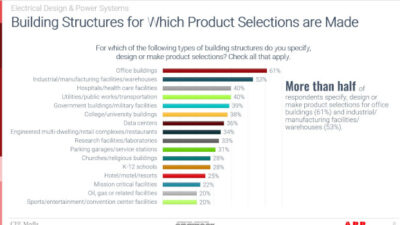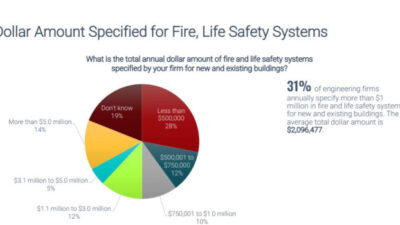CONSULTING-SPECIFYING ENGINEER: Motor control centers (MCCs) seem to be a panacea for many plants—their compact, modular makeup provides space savings and a safe and often environmentally controllable space for critical, sometimes sensitive, motor-related equipment. But are there drawbacks? PEERAN: I do not think there are any.
CONSULTING-SPECIFYING ENGINEER: Motor control centers (MCCs) seem to be a panacea for many plants—their compact, modular makeup provides space savings and a safe and often environmentally controllable space for critical, sometimes sensitive, motor-related equipment. But are there drawbacks?
PEERAN: I do not think there are any. In fact, a motor control center is an elegant way of putting together the starters and speed-control devices of a group of motors powering related processors. But its primary usefulness relates to its location. In other words, it needs to be on the shop floor near the group of motors it is to control. The main advantages of this are convenience in operation and shorter lengths of branch circuits, which helps limit voltage drop.
RAY: I also think motor control centers can be a panacea for many applications, but a number of newer engineers may not be as familiar with the advantages of the MCC platform relative to control panel construction. In general I think there are four keys:
-
Are the applications facilities-centric or machine-centric?
-
Will there eventually be six or more starters involved in the specific application?
-
Does the application contain a mixture of load types/starting methods?
-
Will there be changes in the configuration, size or number of motor loads over time?
BLAIR: I can name even more reasons MCCs are so popular:
-
Most devices are contained within units that can quickly be swapped out, minimizing downtime.
-
MCCs are built and supported by proven manufacturers, as opposed to panels that are generally assembled by small local shops.
-
MCCs are divided into compartments, so faults are contained.
-
MCCs are tested and UL-listed for high fault currents—22 kA to 100 kA—as opposed to panels, which are generally rated 5 kA.
That being said, there are certainly applications where a panel, not an MCC, is the better choice. And as far as the drawbacks of MCCs as a whole, if only a couple of controls are involved, the panel will be cheaper. The MCC contains bus bars, and the cost of these units exceeds the benefit for small applications. Very deep devices are also difficult to fit into MCCs.
CSE: What key issues do engineers have to consider in assembling these centers?
BLAIR: To be honest, MCCs can be somewhat difficult to design and layout, especially for those who infrequently specify MCCs. The opportunity for errors is significant—either by the designer, or misunderstandings during the bid process. And once in the field, problems are tough to fix. To counter this difficulty, MCC manufacturers generally offer free configuration software containing extensive logic to make sure the MCC is buildable and optimized.
RAY: Probably the most important characteristic to consider is the criticality of and the type of maintenance to be performed on the equipment. The basic melting alloy starter and thermal magnetic breaker may be best for commercial facilities with limited maintenance capability. In other words, fix it when it’s broke.
CSE: What are the most common mistakes engineers make in specifying MCCs?
BLAIR: Most mistakes stem from the fact that associated mechanical equipment is still changing when the MCC is specified. The result is in incorrectly sized motor starters, AC drive breakers and fusible disconnects. To minimize this issue, we encourage customers to wait until the design is finalized, and then take advantage of our quick delivery program. The options available are broad enough for us to ship about half of our MCCs within two weeks. Other common mistakes surface along the lines of sub-optimal design, whereby dated technology is specified or unnecessary options are required. Finally, specifiers too often think of MCCs as only housing motor starters, and forget to include AC drives, soft starters or lighting panels. It pains me to see a clean new MCC, and then right next to it some loose components slapped on the wall, with conduit snaking all around them.
PEERAN: The most common mistake that I have come across is that the short-circuit rating of the horizontal and the vertical buses is specified to be only marginally above the calculated short-circuit level. It must be realized that the calculated short-circuit level is correct only for a particular system configuration. If the electrical system configuration is changed due to plant expansion or modification, the short-circuit levels will also change. Therefore, there must be ample margin between the calculated level and the MCC rating to allow for future changes.
RAY: Silver plating of bus and connections is the most frequent misapplication I encounter. Although the standard for almost every major manufacturer is tin plating, many engineers feel they get cooler running bus by specifying silver. In fact, temperature-rise testing sets MCC bus ampacity, and the same temperature limits apply regardless of plating. In-the-field corrosion is a much more significant issue, particularly in water and wastewater applications, where silver is highly susceptible.
CSE: What are the most significant code issues?
BLAIR: From my chair, the most significant new standard permeating our industry is NFPA-79E, which deals with arc flash energy and associated recommended practices for servicing electrical equipment. Also IEEE-519, defining allowable harmonic content, is important as it often results in the use of either 18-pulse drives or active harmonic filters.
RAY: Arc flash hazard and PPE requirements for maintenance staff are definitely critical code issues. Square D is at the forefront of activity designed to identify and mitigate this hazard. The key is to de-energize the equipment and place it in an electrically safe condition prior to opening or entering it. Specifying a local MCC disconnecting means, along with overcurrent protection for the MCC, is the best mitigation, as the MCC can be de-energized without affecting other equipment. It also provides a predictable interruption of an arcing fault, should one occur.
Elsewhere, new seismic requirements in the model building codes are also emerging based on the 1997 National Earthquake Hazards Reduction Program Provisions (FEMA 302). These new model codes include NFPA 5000 and the 2000 International Building Code . These new codes represent a fundamental shift in how seismic requirements are established. These changes were driven by lessons learned from Mexico City in 1985, Loma Perita in 1989 and Northridge in 1994. The old system of classifying locations by seismic zones (such as UBC or CBC Zone 4 in California) will soon be obsolete. Manufacturers and specifiers must work together to apply these new requirements to equipment and installations.
CSE: Finally, along the line of technology developments, what are the latest, greatest MCC innovations?
PEERAN: It appears that MCC design has reached a plateau. Most innovations involve the incorporation of things like electronic metering, communication means, multi-function electronic motor protector relays, solid-state soft starters, VFDs, etc.
RAY: But the increasing use of drives, soft starts and other power electronics will continue as this equipment becomes smaller and cheaper. Additionally, use of Internet technologies for remote monitoring and diagnostics of equipment and process will facilitate remote maintenance and diagnostics as well as a variety of services where third parties can provide analysis.
BLAIR: I believe the biggest development surrounds intelligent devices. Customers prefer having a device-level network built into their MCC, with intelligent devices commissioned and plugged into the network. This approach offers tremendous benefits for improved process monitoring, improved diagnostics and reduced start-up costs.
Participants
Syed Peeran, PhD., P.E. , Chief Electrical Engineer WB Engineering and Consulting Woburn, Mass.
David Ray , MCC Product Line Manager Square D/Schneider Electric Seneca, S.C.
Dave Blair , Marketing Manager MCC Business Rockwell Automation Milwaukee



